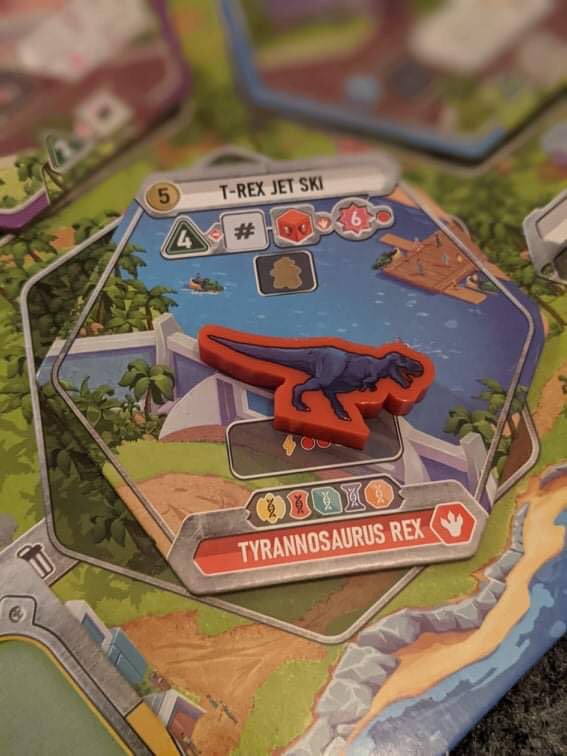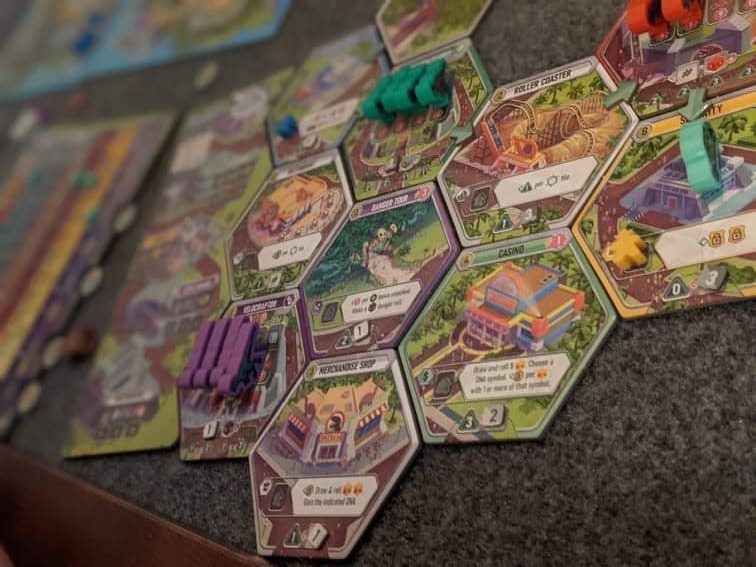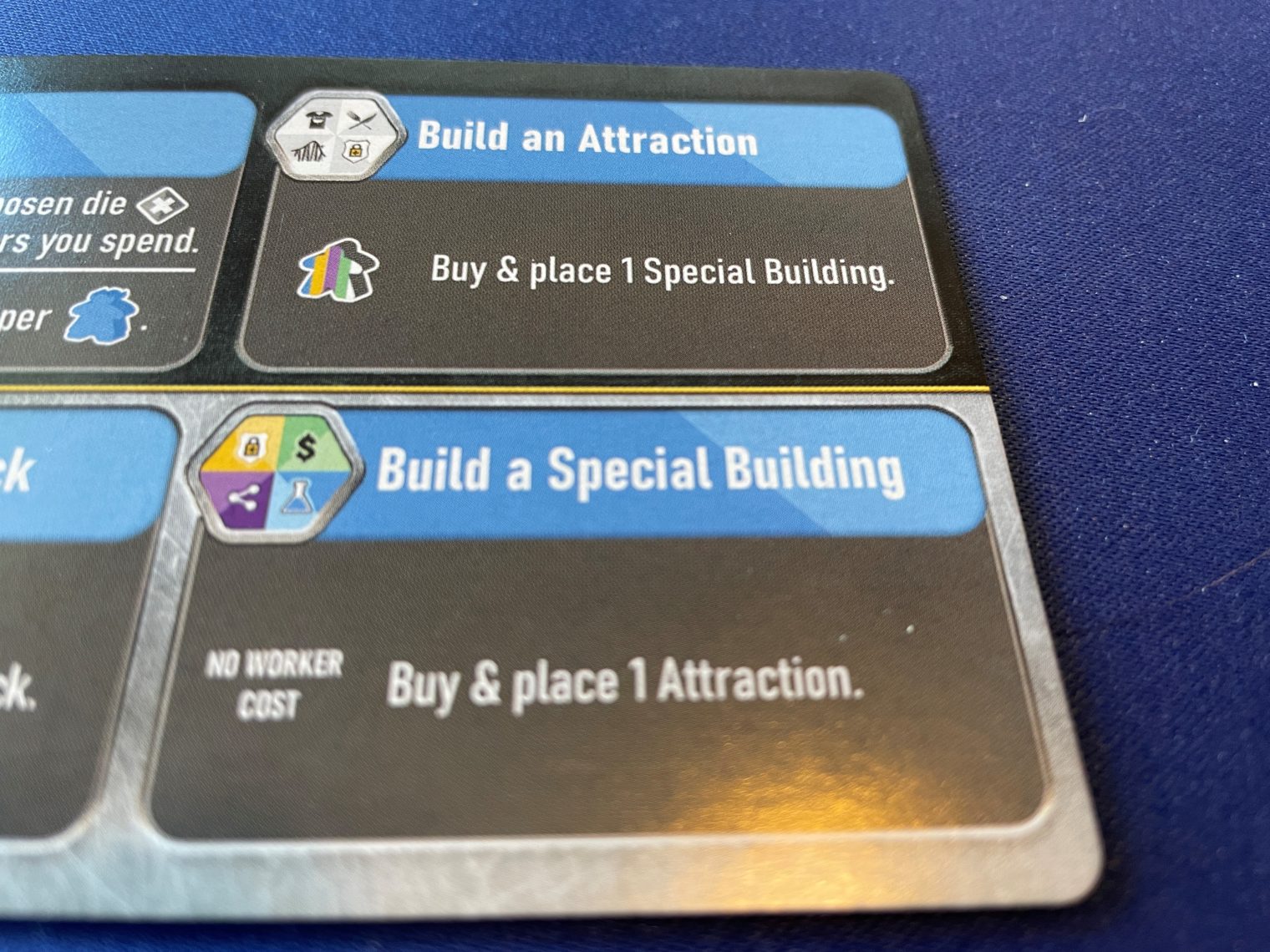The good people at Pandasaurus Games were nice enough to send us a copy of their latest offering in the “What if Jurassic Park was a Game” genre, Dinosaur World—which we’ll shorten to World for this review. Sometimes, when the writers of DWP get to play games, our opinions align quite nicely; other times, the opinions vary drastically. Since the two of us (Billy C and Steve T) have greatly contrasting opinions on this game, we decided to give you two points of view. Let’s dig into why!
First Impressions
Steve: World is quite similar to their first outing in the genre, Dinosaur Island (which we’ll call Island from now on). Having played both games, I see no reason why anyone would need to own both of them.
Billy: Having played Island once and Rawr ‘N Write (Rawr for short from now on) as well, I wasn’t coming into World blind, and the background knowledge I had really helped to inform the plays of World.

Overview
Steve: Both games are about building a theme park filled with live, cloned dinosaurs. Both use DNA dice drafting, and the concept that your security needs must keep up with the threat level created by all your dinosaurs. Both have attractions and facilities to build and laboratories that let you manipulate the DNA you collect. And both are extremely fiddly table hogs that leave one with the contradictory feelings that they are simultaneously too long, and not long enough. I say too long because the fun doesn’t last as long as the play time (the suggested run time of one to two hours stretched into three!), and too short because just as you are getting your park running efficiently enough to have some fun with it, the game ends.
World is a little more hands-on and operational in nature than its predecessor. It adds the new concepts of running tours through your park to generate excitement (and thus money), as well as boredom scores that make your attractions less interesting to visit the more often you visit them. In addition to managing your threat and security levels like in the old game, you also now also have to keep improving your park jeep so it can take your guests to more attractions in a single tour. Improving your jeep also gives you other recurring bonuses, such as free money, DNA, and security upgrades. None of which makes any sense at all to me from a thematic standpoint.
Billy: My initial experience with World was largely positive, enjoying its sense of continuity from Island and Rawr. Any familiarity with the series will make you immediately nostalgic for the Island dice. These big chonky dice covered with DNA and translucent like the amber that inspired them. World uses a similar DNA storage track to keep track of your resources, and the whole production really does feel like a sequel. There are mechanic similarities, but the games really do live in different places in my heart.
World does ask a lot in terms of forward thinking. If you like flying by the seat of your pants and taking it one turn at a time, World might not be the game for you. Each round, players will first acquire workers before going through the next three phases: Public Actions, Private Actions, and the Jeeple Tour. Each of these phases will require workers to differing amounts, and if you blow all your workers in the private actions, you could leave yourself with no workers leftover for the Jeeple Tour. This balance is hard to find, but part of the puzzle that I found so enticing as I played through World.

The Jeeple Tour
Billy: World is fully about the new mechanic that it adds, the Jeeple Tour. Every choice you make revolves around the tour – workers you acquire, money you spend, dinos you breed, and tiles you purchase – every single action in the game is to make a strong Tour. Cards on the table, I think this mechanic is an absolute triumph. The way the rest of the game comes together around this spine makes World something I am excited to revisit. As you repeatedly visit different dinosaurs and attractions in your park, the visitors grow bored, garnering you less excitement and less money. Capitalism drives the game as continuous expansion and new content is needed to keep up with the flock of insatiable consumers. Some of the better buildings don’t even generate excitement at all, and to use their effects repeatedly on tour, you’ll have to build exciting attractions around them. Nobody is going to tour your Security Office unless they get to see some pretty cool dinosaurs along the way!
Steve: Mechanically, boredom is an area the game falls down. It’s an incredibly fiddly mechanic that doesn’t make the game anymore fun for its presence. It would have been much easier to make it a rule that you can’t visit any places on a tour that you visited on the previous tour. It would have meant fewer components to produce, and less math for the player to perform during play. Frankly, the idea that visiting a T-Rex paddock a second time would be “boring” feels ridiculous.
The idea of plotting a jeep route through your park to entertain guests is really neat; unfortunately in practice, due to the way the rules work, you will likely build a number of buildings that never get used. Your jeep’s travel range is limited, unless you sink a lot of workers and money into improving it, so for much of the game, you’ll only be able to visit 3 features per tour. Even with the best jeep in the world, you’ll only get to see five features, and your park will have easily twice that number. And because your pool of 9 (or maybe 10) workers per turn have to be rationed between performing all the public actions you may want to do, plus all the private actions, and activating most of the features you visit on a tour, there is a strong chance that you won’t be able to actually use all the park features your tour hits. The game promises all these cool toys to play with, but then actively prevents you from engaging with everything you build, let alone all the toys in the game.
Complexity & Components
Steve: World is trying, in my opinion, to be too many things all at once. It has worker placement, resource management, drafting, action selection, tech trees, tile placement, set collection, and more, all jammed into one game. It is overwhelming for new players, but not in a good way. Some overwhelming games leave a player thinking about how to do better next time they play. Half my players never wanted to play again, and one was so swamped by the decisions to be made, and lacking the information to make them, that he ended up with negative victory points in the end because of all the deaths in his park.

The components are pretty, and sturdy, but contain some baffling choices and outright errors that never should have made it to production. The meeple workers come in different colours and shapes to help differentiate the roles they can play in your park. Cool. So why do the scientist meeples have horns like Vikings? [Pandasaurus Games has responded with: “the Scientists meeples have ‘crazy scientist hair'”.] The reference cards have mistakes on them that really should have been caught before printing. The rules for building attractions and building special buildings have been swapped for example. And one of the actions shows the wrong type of associated meeple on the card. Also, on the players’ private action boards, the decision was made that the +1 coin symbol would be used to mean both “gain an extra coin” in one place, and “spend one less coin” in two other places. That’s a big whoops.
Billy: As far as the depth and complexity of this game goes, I think the box time listed (60-120 minutes) is absolutely unrealistic unless your group is zooming. All of my plays have extended beyond two and a half hours, at various player counts. One of the reasons for this problem stems from, I think, how the rules suggest approaching the different phases. As I mentioned above, the game basically *is* the Jeeple Tour, which the game suggests you do simultaneously. Really, the only parts of the game that the rulebook suggests you do in turn order is picking your workers, public actions, and the cleanup phase. I was really interested in showing off the sum of all my actions to the other players and seeing what they accomplished. I suppose you could do this portion of the game simultaneously and maybe the 120 minute description would be adequate, but the game would be worse.

With an excellent opinion of the mechanics and the publisher, I was prepared to fall in love with this beautiful, deluxified Kickstarter. But, truly, World is riddled with production errors – the Kickstarter feels rushed and poorly thought-out. The game presents an absolutely massive and impressive table presence, fitted with stunning art, but all of the text on the tiles are absolutely tiny and illegible. I cannot think of a way to make the valuable information visible for all players if there are more than two of them. Thankfully the game provided excellent player aids, right? Nah, the player aids have blatant errors on them and present just one more “okay, but” that you have to go through to teach this game to your friends. [Pandasaurus has since provided a link to a Dropbox folder with corrected player aids.]
And, as Steve mentioned above, the boredom mechanic is incredibly fiddly. Unlike Steve, I think the mechanic is excellent and inspired, but it has been executed in the worst possible way. Often when people criticize a game by saying it is too “fiddly” I worry that that criticism comes from a place of not liking games that have moving parts working together. I absolutely adore games that have been called fiddly hundreds of times, but this mechanic actually is “fiddly”. It is fiddly like first printing Terraforming Mars was fiddly, exacerbated exponentially. The pieces are punched cardboard half the size of a Tic Tac and you have to add and remove them relatively frequently. It is another issue of the production design of this game truly failing to understand both the power of a human being’s vision and the size of their hands.
Final Thoughts
Steve: The game is well-regarded on Board Game Geek, with a 7.5/10 average rating, so there are clearly people out there who like it, but my group does not consider itself among them. A major complaint from my group was the lack of player interaction. No interaction is not a bad thing in and of itself, but that depends on player preference, so if you like highly interactive games, World is not what you’re looking for. And worse than having very little interaction, it pretends that it has interaction by being a worker placement game with a “public actions” phase. The public action phase boils down to “can I do what my opponent wanted to do first?” and considering the size of the board and the minute size of the icons on the tiles, it is practically impossible to see what your opponents are up to, so “doing their thing first” is pretty much just a matter of luck. Add to it that there are enough attractions for sale that everyone can buy one of each (and the rules prevent you from buying more than one of each), and the race to do things first in the public actions phase is diminished even further.
Another reason the game failed with my group is its overly complex nature. Over the years, my tastes have been moving away from complex games in general, but I am not against games with a lot going on, if the game backs up the complexity with engaging game play. Star Wars Rebellion, Fury of Dracula, and Battlestar Galactica are all games with a lot going on in them, that I happen to enjoy. Dinosaur World just has a lot going on.

Billy: World manages to create an excellent puzzle, from choosing the workers to use for the round to planning your park and how you will visit your various attractions. The engagement between players lacks at any individual point, but due to one of the final scoring mechanics, I find watching the other players’ plans to be a requirement of the game. At the end of the game, every player compares deaths (accrued throughout the game) and gets rid of the same number of deaths, the amount of the player who had the fewest. Deaths can, unsurprisingly, be very bad – if you don’t pay attention to the pacing of the group and end up with a lot of deaths, you can lose massive points at the end of the game. This mechanic creates a bizarre game of chicken where players can push their luck to the very edge, but the player who pushes too far can be punished massively. I expect this could cause some horrible feel-bad moments, but in my groups the game of chicken was exciting to be a part of as we watched the others push just a little bit farther.
The Jeeple Tour, the deaths game of chicken, the worker assignment – each of these could be the main mechanic in a different game, but Dinosaur World combines them all in a way that tickles my gaming brain and makes me want to make just one more velociraptor. What’s the worst that could happen?
Fascinating commentary, friends, thank you for that comparison! I saw folks playing Dinosaur World at GenCon a few times and stopped to watch. While I realize that a casual gander doesn’t get across what’s great about a game, and yet and yet…I think I might be in Steve’s camp, leaning more and more towards less complex games, or at least more concise complexity, if that makes sense. The sprawl of World turned me right off.
That said, I was fascinated by the death mechanic y’all mentioned–is that something from Island as well? It would seem to be a hilarious and integral thematic element if you’re basically gamifying Jurassic Park et al. And one that my daughter and I added into our fable-style campaign we’re designing for Draftosaurus. Death in Draftosaurus? Yes!
Hi Alice!
Dinosaur Island’s death mechanic is simply -1 VP per death, which is much less punishing for those with many deaths, but more punishing for the player’s with a few deaths. It’s a much more even punishment than World’s.
Death in Draftosaurus sounds hilarious and I’m so curious about how you have implemented that with your daughter.
Thanks for reading! – Billy
[…] true masterpiece where dice-rolling meets strategic [tile placement](https://tabletoptrove.com/crafting-the-board-the-evolution-of-tile-placement-modular-game-design), […]